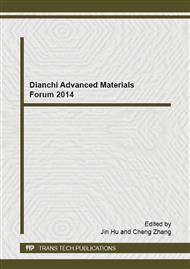[1]
Z.X. Yuan, L. Lv. Study on the latent dibasic-acyl hydrazine curing epoxy dope power with DSC, Journal of Wuhan Food engineering institute. 3 (1997) 13-17.
Google Scholar
[2]
Z.Y. Zhang. Determine the crystal capacity of high polymer with DSC, Applied chemistry. 10(1997) 47-50.
Google Scholar
[3]
H.M. Pan, S.J. Huang, P. Liu. Study on the UV and heat curing process of alicyclic epoxy/sulfate syetem with DSC, Chinese adhesive. 3(1994) 1-4.
Google Scholar
[4]
Y.J. Feng, Y.Q. Shi, D.M. He. Study on the curing heat decomposition kinetics, J. Material science and project of high polymer. 13(1997) 30-34.
Google Scholar
[5]
J. J. Y. Yuan, C.Y. Pan, R.K. Bai. The synthesization and polymerization of the spiral ring monomer and its curing reaction with epoxy resin, J. Chinese adhesive. 14(1997) 25-28.
Google Scholar
[6]
S.G. Luo. The chemical structure curing reaction characteristics and aging degradation of the adhesive prepolymer in NEPE, J. Bei jing university of technology Degree paper. (1997) 4-200.
Google Scholar
[7]
F. Mustata, T. Nita, I. Bicu. The curing reaction of epoxidized methyl esters of corn oil with Diels- Alder adducts of resin acids. The kinetic study and thermal characterization of crosslinked products, J. Journal of Analytical and Applied Pyrolysis. 108 (2014).
DOI: 10.1016/j.jaap.2014.04.007
Google Scholar
[8]
M. Ghaffari, M. Ehsani, H. A. Khonakdar, G.V. Assche, H. Terryn. The kinetic analysis of isothermal curing reaction of an epoxy resin-glassflake nanocomposite, J. Thermochimica Acta. 549 (2012) 81-86.
DOI: 10.1016/j.tca.2012.09.021
Google Scholar
[9]
M. Edelmann, G. Heinrich. Thermokinetic analysis of two-step curing reactions in melt: Part II. Investigation of polymeric model systems, J. Thermochimica Acta. 499(2010)160–165.
DOI: 10.1016/j.tca.2009.12.006
Google Scholar
[10]
A.M. Shanmugharaj, S. H. Ryu. Study on the effect of aminosilane functionalized nanoclay on the curing kinetics of epoxy nanocomposites, J. Thermochimica Acta. 546(2012) 16–23.
DOI: 10.1016/j.tca.2012.07.026
Google Scholar
[11]
H. Xie, W. f. Shi. Polymer/SiO2 hybrid nanocomposites prepared through the photoinitiator-free UV curing and sol–gel processes, J. Composites Science and Technology. 93(2014)90–96.
DOI: 10.1016/j.compscitech.2014.01.004
Google Scholar
[12]
J. Steinhaus, B. Moeginger, M. Großgarten, M. Rosentritt, B. Hausnerova. Dielectric analysis of depth dependent curing behavior of dental resin composites, J. Dental Materials. 30(2014) 679–687.
DOI: 10.1016/j.dental.2014.03.002
Google Scholar


